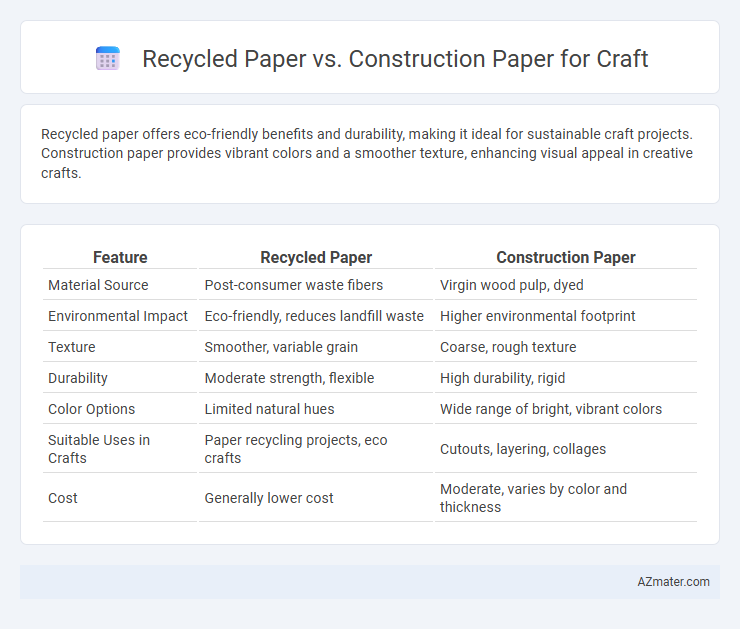Recycled paper offers eco-friendly benefits and durability, making it ideal for sustainable craft projects. Construction paper provides vibrant colors and a smoother texture, enhancing visual appeal in creative crafts.
Table of Comparison
| Feature | Recycled Paper | Construction Paper |
|---|---|---|
| Material Source | Post-consumer waste fibers | Virgin wood pulp, dyed |
| Environmental Impact | Eco-friendly, reduces landfill waste | Higher environmental footprint |
| Texture | Smoother, variable grain | Coarse, rough texture |
| Durability | Moderate strength, flexible | High durability, rigid |
| Color Options | Limited natural hues | Wide range of bright, vibrant colors |
| Suitable Uses in Crafts | Paper recycling projects, eco crafts | Cutouts, layering, collages |
| Cost | Generally lower cost | Moderate, varies by color and thickness |
Introduction: Understanding Recycled Paper and Construction Paper
Recycled paper is made from reclaimed fibers, reducing environmental impact by minimizing waste and conserving resources, while construction paper is a durable, colored paper primarily designed for crafting with a coarse texture. Recycled paper often features a more natural, muted color palette and varies in thickness depending on the source material. Construction paper, commonly used in schools and art projects, offers vibrant colors and firm quality, ideal for cutting, folding, and layering in crafts.
Material Composition: What Sets Them Apart
Recycled paper is primarily made from post-consumer waste such as discarded office paper and newspapers, resulting in a fibrous texture with varying thicknesses and eco-friendly credentials. Construction paper consists of ground wood pulp mixed with dyes and fillers, giving it a dense, vibrant color and a rough surface ideal for cutting and folding. The key material difference lies in recycled paper's sustainable origin versus construction paper's chemically treated, pigment-enhanced composition.
Sustainability and Environmental Impact
Recycled paper reduces deforestation and energy consumption by repurposing post-consumer waste, making it a more sustainable option for crafts compared to traditional construction paper. Construction paper often relies on virgin pulp and chemical dyes, contributing to higher carbon emissions and environmental degradation. Choosing recycled paper supports circular economy practices and minimizes landfill waste, enhancing overall environmental stewardship in crafting activities.
Color Range and Aesthetic Qualities
Recycled paper offers a more limited color range with muted, earth-toned shades, emphasizing eco-friendly aesthetics and a textured, natural look ideal for rustic or vintage crafts. Construction paper provides a vibrant, broad spectrum of bright colors with a smooth, consistent texture, making it suitable for bold, eye-catching designs and children's projects. Choosing between the two depends on whether the craft prioritizes environmental sustainability and subtle hues or vivid colors and uniform finish.
Texture and Workability for Crafts
Recycled paper features a rougher texture due to its fiber composition, offering a rustic, natural look ideal for eco-friendly craft projects but can be less smooth for detailed work. Construction paper has a more uniform, coarse texture that provides sturdiness and vibrant color retention, enhancing workability for cutting, folding, and gluing in school crafts. Both papers vary in thickness and flexibility, impacting the precision of intricate designs and the durability of finished crafts.
Durability and Longevity in Art Projects
Recycled paper offers moderate durability and is eco-friendly, making it suitable for short-term craft projects; its fibers are often shorter, which can result in reduced strength and wear resistance compared to construction paper. Construction paper, made from virgin wood pulp with added dyes and fillers, provides superior durability and vibrant color retention, ideal for long-lasting art projects requiring structural integrity and consistent appearance. Artists focusing on longevity and robustness typically prefer construction paper for its ability to withstand handling and maintain visual appeal over time.
Cost Comparison: Budgeting for Craft Supplies
Recycled paper typically costs less than construction paper, making it a budget-friendly option for large-scale craft projects. Construction paper tends to have a higher price due to its thicker texture and vibrant colors, which may be preferable for certain artistic needs. Choosing recycled paper reduces both expenses and environmental impact, offering a cost-effective and sustainable crafting supply choice.
Compatibility with Art Mediums and Techniques
Recycled paper offers excellent compatibility with a variety of art mediums such as colored pencils, markers, and watercolors due to its smooth texture and absorbency, making it ideal for detailed and mixed-media projects. Construction paper, characterized by its rougher surface and thicker fibers, is best suited for crayon, pastel, and collage techniques but may struggle with wet media as it tends to warp or bleed. Choosing between recycled and construction paper depends on the specific art mediums and techniques, with recycled paper providing versatility and construction paper excelling in sturdiness for tactile crafts.
Availability and Sourcing Options
Recycled paper is widely available through eco-friendly suppliers and major office supply stores, making it an accessible option for sustainable crafting projects. Construction paper, commonly found in art stores and educational retailers, offers a broad color range but typically lacks recycled content. Sourcing recycled paper supports environmental impact reduction, while construction paper emphasizes vibrant colors and texture variety for diverse craft applications.
Choosing the Right Paper: Which Is Best for Your Craft?
Recycled paper offers eco-friendly benefits with a smooth texture ideal for detailed drawing and lighter crafts, while construction paper provides vibrant colors and a sturdier feel perfect for bold cutouts and layered projects. Selecting the right paper depends on the craft's durability needs and environmental impact; recycled paper suits sustainable art, whereas construction paper excels in structural crafts and children's projects. Consider thickness, color vibrancy, and texture to match your creative vision and functionality requirements.

Infographic: Recycled paper vs Construction paper for Craft
 azmater.com
azmater.com